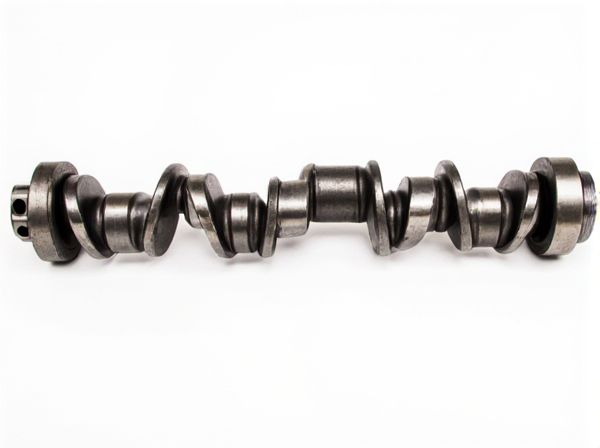
Photo illustration: Hollow vs Solid Crankshaft
A hollow crankshaft offers reduced weight, improving engine efficiency and responsiveness without compromising strength. Your choice between hollow and solid crankshafts affects durability, as solid shafts typically provide greater rigidity and resistance to stress. Evaluating your engine's performance needs helps determine whether lightweight design or maximum toughness is more critical.
Table of Comparison
| Feature | Hollow Crankshaft | Solid Crankshaft |
|---|---|---|
| Weight | Lightweight, reduces engine mass | Heavier, adds to engine weight |
| Strength | Good strength-to-weight ratio | Higher absolute strength |
| Cost | More expensive due to complex manufacturing | Lower cost, simpler to produce |
| Durability | Less durable under extreme stress | Highly durable and resistant to wear |
| Performance | Improves engine responsiveness and fuel efficiency | Stable performance under heavy loads |
| Applications | High-performance and lightweight engines | Heavy-duty and commercial engines |
Introduction to Crankshaft Types
Crankshafts are crucial components in internal combustion engines, converting linear piston motion into rotational energy. Hollow crankshafts reduce weight and increase engine efficiency by maintaining strength while lowering inertia, making them ideal for high-performance applications. Solid crankshafts provide durability and rigidity, commonly used in heavy-duty engines due to their robustness and resistance to torsional stress.
Overview: Hollow vs Solid Crankshafts
Hollow crankshafts offer reduced weight and improved rotational inertia, enhancing engine efficiency and responsiveness compared to solid crankshafts. Solid crankshafts provide superior strength and durability, making them ideal for high-performance or heavy-duty applications. The choice between hollow and solid crankshafts depends on balancing weight reduction benefits with mechanical strength requirements in engine design.
Manufacturing Processes Compared
Hollow crankshafts are typically manufactured using advanced methods such as hydroforming or forging with subsequent precision machining, which reduces weight without compromising strength. Solid crankshafts undergo traditional forging or casting followed by extensive machining to achieve their final shape, offering higher overall rigidity but increased mass. The hollow design requires complex quality control techniques like ultrasonic testing to ensure structural integrity, whereas solid crankshafts are more straightforward to inspect and produce at lower costs.
Material Selection and Structural Integrity
Hollow crankshafts typically use high-strength alloy steels such as chromium-molybdenum or nickel-chromium steels to balance reduced weight with enhanced fatigue resistance, while solid crankshafts often utilize forged or cast steel with higher mass and robustness. The hollow design improves structural integrity by lowering rotational inertia, leading to better engine responsiveness and reduced stress concentrations, whereas solid crankshafts provide superior durability under extreme load conditions due to their uniform cross-section. Material selection directly influences the crankshaft's ability to withstand cyclic loading and fatigue, making high-grade alloy composition critical for optimizing strength-to-weight ratio in both hollow and solid configurations.
Weight Differences and Performance Impact
Hollow crankshafts significantly reduce engine weight by up to 20% compared to solid crankshafts, enhancing vehicle acceleration and fuel efficiency. The reduced rotational mass lowers inertia, resulting in quicker engine response and higher RPM potential. Despite being lighter, hollow crankshafts maintain structural integrity through advanced manufacturing processes, ensuring durability without compromising performance.
Torsional Strength and Durability
Hollow crankshafts offer superior torsional strength due to their optimized weight distribution, which allows them to absorb and dissipate stress more effectively than solid crankshafts. This enhanced torsional rigidity contributes to increased durability, especially in high-performance engines where resistance to twisting forces is critical. Solid crankshafts, while robust, tend to have higher mass and lower stress distribution efficiency, potentially leading to faster fatigue under extreme torsional loads.
Efficiency and Fuel Economy Considerations
Hollow crankshafts reduce engine weight by up to 10-15%, leading to lower rotational inertia and improved throttle response that enhances overall efficiency. Solid crankshafts, while heavier, offer greater durability and withstand higher torque loads, which can be advantageous for high-performance engines but may slightly reduce fuel economy due to increased mass. Choosing a hollow crankshaft often results in better fuel economy by lessening engine load and improving balance, making it ideal for passenger vehicles prioritizing efficiency.
Applications in Automotive and Motorsport
Hollow crankshafts are favored in automotive and motorsport applications due to their reduced weight and improved rotational dynamics, which enhance engine responsiveness and fuel efficiency. Solid crankshafts, known for their durability and strength, are typically used in heavy-duty vehicles and high-performance motorsport engines where maximum torque and stress resistance are critical. In motorsport, lightweight hollow crankshafts contribute to faster acceleration and higher RPM capabilities, while solid crankshafts ensure reliability under extreme operating conditions.
Cost Analysis: Investment and Maintenance
Hollow crankshafts typically involve higher initial investment costs due to advanced manufacturing processes such as precision machining and material treatments, but they offer lower maintenance expenses because of reduced weight and improved fatigue resistance. Solid crankshafts have lower upfront costs because of simpler manufacturing techniques but incur higher long-term maintenance due to increased wear and potential for imbalance. Evaluating total cost of ownership, hollow crankshafts can be more economical in high-performance or long-term applications where maintenance savings offset initial investment.
Choosing the Right Crankshaft for Your Engine
Selecting the right crankshaft depends on the balance between strength, weight, and engine application. Hollow crankshafts offer reduced weight and improved engine response, making them ideal for high-performance or racing engines, while solid crankshafts provide superior durability and are better suited for heavy-duty or industrial engines. Evaluating engine requirements, RPM range, and load conditions ensures optimal crankshaft performance and longevity.
 caratoz.com
caratoz.com